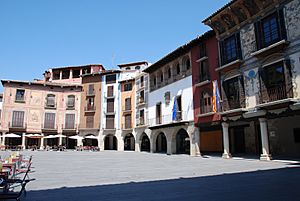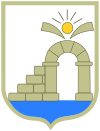Graus facts for kids
Quick facts for kids
Graus
|
|||
|---|---|---|---|

Main Square, Graus
|
|||
|
|||
| Country | |||
| Autonomous Community | |||
| Province | |||
| Comarca | Ribagorza | ||
| Judicial district | Barbastro | ||
| Area | |||
| • Total | 299.79 km2 (115.75 sq mi) | ||
| Elevation | 542 m (1,778 ft) | ||
| Population
(2018)
|
|||
| • Total | 3,305 | ||
| • Density | 11.0244/km2 (28.553/sq mi) | ||
| Demonym(s) | Grausino | ||
| Time zone | UTC+1 (CET) | ||
| • Summer (DST) | UTC+2 (CEST) | ||
| Postal code |
22430
|
||
| Patron Saints | Vincent Ferrer | ||
Graus is a charming village in the Spanish province of Huesca. It is nestled in the Pyrenees mountains. The village sits where the Esera and Isabena rivers meet. Graus is the main town for its region. It is also one of the few places in Aragon where the Aragonese language is still spoken.
A famous battle, the Battle of Graus, happened here. Also, a well-known Spanish thinker, Baltasar Gracián y Morales, lived here for a time. During the Spanish Civil War around 1936, Graus was an important local trading center. About 2,600 people lived there at that time.
Contents
Geography of Graus
The area of Graus includes many smaller towns and villages today. Some of these are Abenozas, Aguilar, Aguinalíu, Bellestar, and Benavente de Aragón. Other towns are Castarlenas, Centenera, Eixep, Güel, Chuseu, Panillo, La Puebla de Fantova, La Puebla del Mon, Pueyo de Marguillén, El Soler, Torre de Ésera, Torre de Obato, Torrelabad, Torres del Obispo and Las Ventas de Santa Lucía.
There are also some villages that are no longer lived in. These include Bafaluy, Cancer, Erdao, Fantova, Grustán, Pano, and Torruella de Aragón.
History of Graus
People first lived in Graus a very long time ago, during the Paleolithic period. We know this from old remains found near Morral Rock.
Graus was once one of the northernmost places controlled by Islam in Spain. Christian forces took it back in 1083. This happened during the Battle of Graus, led by Sancho Ramirez. Earlier, in 1064, King Ramiro I had died trying to capture Graus. After the battle, Graus was given to the St. Victorian of Asan monastery. They helped rebuild the town and encouraged people to move there. They even gave special benefits to new residents.
In 1223, King Peter II of Aragon gave Graus a special title. He called it the "Very Noble and Very Old Village of Graus." The town still proudly uses this title today.
In 1415, a Dominican friar named St. Vincent Ferrer visited Graus. He was invited by Berenguer de Bardaxi. Three years earlier, both men had helped solve a big problem about who would rule the Crown of Aragon. St. Vincent Ferrer preached in Graus and was very popular. As a thank you, he gave the town a crucifix. This crucifix is still kept and honored in the local church. The main festivals in Graus celebrate this visit and the special gift.
Later, in 1588, King Philip II of Spain started a weekly market in Graus every Monday. This market is still held today! In 1681, King Charles II of Spain added the Santa Lucia fair, which happens every May.
The 16th and 17th centuries were a time of great wealth for Graus. This allowed the village to build many grand houses. Most of these beautiful mansions still stand around the amazing Main Square and other parts of the village. During these centuries, the most important building in Graus was also built: the Basilica of Our Lady of the Rock.
In the 1920s, Graus grew by adding the towns of Barasona and Benavente de Aragón. In the 1960s, it added Aguinalíu, Panillo, Puebla de Fantova, and Torruella de Aragon. Finally, in the 1970s, Graus welcomed Chuseu, Güell, and Torres de Chuseu into its municipality.
Culture and Traditions
Graus has many unique cultural traditions.
Baile de las Espadas (Swords Dance)
This dance has three different music parts: "Cardelina", "Taninaná", and "Culebreta" (Small Snake). Twenty dancers and two "repatanes" perform it in five groups. The dancers in the middle group wear the most eye-catching outfits. They have fancy lace, stockings, gloves, necklaces, and flowered hats. This special costume might have been a way to include a feminine touch in a dance that was originally just for men. It used to celebrate strength and new life.
Baile de las Cintas (Ribbon Dance)
This dance is newer than the Swords Dance. Its music is a traditional Graus polka from the late 1800s. An orchestra plays it now, but it used to be played on bagpipes. Dancers hold ribbons and dance around a tall pole decorated with ribbons and flowers. This dance represents an old celebration of new life and growth. Before the 1960s, only men danced it. Now, both boys and girls dance in pairs, and there are eight pairs instead of four. Everyone wears the traditional Graus costume.
La Mojiganga
This is a funny and playful show performed every September 13. It makes fun of things that happened in the town during the year. This show has been stopped many times because of its bold nature. It was stopped during the French invasion (1809-1813) and due to bad harvests (1834-1838). The longest stop was from the time of Primo de Rivera's government until it returned in 1979. Before the Mojiganga show, there's a parade. It still has parts from medieval times, like the "estafermo" and "tarasca." These are moving dolls that clear the way for the Mojiganga performers.
La Llega
This tradition helps collect money for the Holy Christ Confraternity. People walk through the village, dancing to bagpipes and loud blunderbusses. They carry large wooden sticks. During "La Llega," they share "el cordoné." This is a small blessed ribbon that many people tie around their wrists.
Las Albadas
These are songs sung through the streets of the town at night. They come from Moorish times. The songs tell stories of love and praise popular people from the village.
El Llibré
To get all the information about the popular festivals in Graus, a "llibré" (which means little book in Graus Aragonese) is published each year. It includes the festival program, poems, stories, and other writings. Most of these are written in Graus Aragonese.
Celebrations in Graus
Town Festival
The main Town Festival is from September 12 to 15. It honors the Holy Christ and Saint Vicent Ferrer. This festival is so special that it's called a "National Touristic Interest." This is because of its many rich traditions. These include one of the best-preserved bagpipe tunes and dances in Aragon, called the "Baile de las Espadas" (Swords Dance). There are also traditional giants and "cabezudos" (big heads), blunderbusses, "Albada songs," and one of the best "mojiganga" shows in Spain.
Longaniza Festival
The "Fiesta de la longaniza" (Festival of the Longaniza) is a famous local food festival. Every year, on the last weekend of July, people prepare the world's largest barbecue. Since 1997, they cook 1100 kg (about 2,425 pounds) of longaniza sausage!
Delicious Food of Graus
The most famous food from Graus is the longaniza sausage. It's a true local treat and has a special "Q for Quality" award in Aragon. Its importance is celebrated every year on "Longaniza Day," which is the last weekend of July.
Another special dish from this part of Aragon is "chireta." It's made from lamb guts stuffed with rice and meat. The guts are then sewn up and boiled.
Graus is also known for having one of the biggest markets for black truffles in Spain.
Famous People from Graus
- Joaquín Costa (1846–1911): He was a famous thinker and politician. Although he was born in Monzón, he lived most of his life in Graus. People knew him as "The Lion of Graus."
- Eusebio Bardají Azara (1776–1842): He was a lawyer and a diplomat.
- Diego Cera (1762-1832): He was a notable organ builder. He built the organ in San Francisco Church (in Intramuros, now gone). He also built the world-famous Bamboo Organ in Las Piñas.
Twin Towns
Graus is twinned with:
 Tournefeuille, Haute-Garonne, France
Tournefeuille, Haute-Garonne, France
See also
 In Spanish: Graus para niños
In Spanish: Graus para niños




